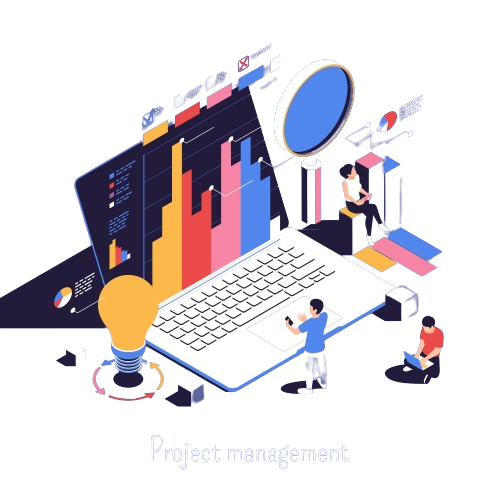
Effective undertaking control has become synonymous with fulfilment in the dynamic landscape of cutting-edge business. Whether you are a seasoned project supervisor or a newcomer, expertise in project management software programs and adopting strategic techniques can affect your project results extensively. This comprehensive manual will take you on an adventure from the basics to advanced techniques, empowering you to master the art of undertaking control.
The Essence of Project Management
A. Defining Project Management
Project management is a systematic approach to planning, organizing, and executing tasks to attain particular desires and targets within a described time frame and finances. It entails coordinating diverse sources, responsibilities, and groups to ensure the successful finishing touch of a mission. Project management aims to optimize the use of assets, mitigate dangers, and supply excellent results that meet or exceed stakeholder expectations.
B. The Importance of Efficient Project Management
Efficient task control is a vital factor in the success of any endeavor, be it a small-scale initiative or a large, complicated project. It includes strategically applying standards, tactics, and gear to devise, execute, and execute tasks efficaciously.
The impact of efficient project management extends throughout diverse factors of an agency and is integral to achieving enterprise targets. Here are key motives highlighting the significance of efficient mission control
- Timely Delivery: Efficient project management guarantees tasks are finished within stipulated cut-off dates. This is vital for meeting client expectations, retaining effective recognition, and positioning the agency as dependable and trustworthy.
- Cost Efficiency: Effective challenge control minimizes the danger of financial overruns. Be cautious in planning, useful resource allocation, and tracking; initiatives are more likely to stay within budget constraints, optimizing using economic assets.
- Focus on Objectives: Project management maintains the point of interest on mission desires and objectives. Through meticulous planning and execution, groups are guided closer to achieving predefined milestones, ensuring that the venture aligns with the wider strategic goals of the organization.
- Efficient Resource Allocation: Project managers allocate human, economic, and technological assets efficiently. This maximizes aid utilization, prevents bottlenecks, and complements standard assignment efficiency.
- Identifying and Addressing Risks: Efficient venture control includes proactive hazard assessment. By figuring out capacity risks early in the project lifecycle, teams can develop mitigation strategies, lowering the chance of disruptions and setbacks.
- Focus on Quality: Project management emphasizes turning in exquisite consequences. By incorporating high-quality assurance measures into task planning and execution, businesses ensure that deliverables meet or exceed stakeholders’ expectations.
- Meeting Expectations: Efficient challenge control contributes to client satisfaction by delivering initiatives that meet or surpass expectations. Satisfied customers are much more likely to become repeat clients and advocates for the company.
- Effective Collaboration: Project management fosters collaboration amongst group participants. Clear verbal exchange channels, described roles, and shared objectives beautify team productivity and brotherly love.
- Flexibility in Execution: Efficient undertaking control allows flexibility in adapting to changing instances. This is particularly important in dynamic business environments where venture requirements can evolve.
- Learning from Experience: After the assignment finishes touch, a radical assessment enables perceived regions for development. This commitment to non-stop improvement refines project management methods and increases organizational efficiency.
- Building Credibility: Consistently delivering projects successfully complements an enterprise’s recognition. This, in flip, attracts customers, partners, and pinnacle skills, contributing to a sustained boom.
Navigating Project Management Software
A. Understanding Project Management Software
A project control software program is a transformative device designed to streamline and beautify the efficiency of project-related obligations and collaboration inside a business enterprise. As companies and teams grapple with increasingly more complex projects, the need for a centralized platform that facilitates making plans, verbal exchange, and coordination has become paramount. This section delves into the critical aspects of project management software programs, elucidating their key features and significance in cutting-edge mission management.
B. Key Features
- Project Scope: Defining the challenge scope is the first step in project management. This includes outlining the desires, deliverables, responsibilities, cut-off dates, and universal assignment targets. A nicely defined scope presents a roadmap for the task team and stakeholders.
- Planning: Project-making plans entail breaking the overall venture into smaller, conceivable tasks. This includes figuring out dependencies, organizing timelines, allocating resources, and creating a comprehensive undertaking plan. Planning sets the foundation for successful project execution.
- Organizing: Efficient organization is essential for coordinating project activities and resources. This consists of structuring teams, assigning roles and duties, and setting up conversation channels. An effective agency ensures that everybody worried about the undertaking knows their responsibilities and responsibilities.
- Execution: The execution segment involves placing the task plan into action. This consists of assignment implementation, resource allocation, and continuous development monitoring. Project managers play a critical position in overseeing the execution segment, addressing problems as they stand up, and making sure that the mission stays on the path.
- Monitoring and Controlling: Throughout the assignment lifecycle, tracking and controlling are crucial to tune development, pick out deviations from the plan, and enforce corrective movements. Regular assessments help assignment managers make informed choices and hold the undertaking on the right track.
- Communication: Open and obvious communique is a cornerstone of successful task management. Project managers must establish powerful communication channels to inform crew individuals, stakeholders, and other applicable events about assignment traits, adjustments, and milestones.
- Risk Management: Identifying and dealing with risks is vital to project management. This entails assessing capacity risks, growing techniques to mitigate them, and having contingency plans in the region. Proactive threat control minimizes the impact of unforeseen demanding situations at the mission.
- Closure and Evaluation: Once the venture is completed, an intensive assessment is carried out to assess the task’s success against its objectives. This consists of analyzing what laboured nicely, regions for development, and classes discovered. Proper undertaking closure guarantees that all deliverables are met and stakeholders are satisfied.
C. Popular Project Management Tools
- Trello: Known for its intuitive card-primarily based device, Trello is appropriate for smaller projects and agile groups.
- Asana: With a strong mission control device, Asana is good for groups looking for exact mission tracking.
- Jira: Tailored for software development initiatives, Jira provides effective difficulty- and challenge-tracking competencies.
- Monday.Com: Combining venture management and team collaboration, Monday.Com is a flexible tool for numerous industries.
Choosing the Right Software
Choosing the right project management software is a critical decision that could drastically affect the fulfilment of your tasks and the overall efficiency of your group. With many alternatives available, every imparting particular functions and talents, making a knowledgeable preference requires careful consideration. Here’s a comprehensive guide on a way to select the proper undertaking control software for your needs:
Assess Your Project Requirements
- Project Size and Complexity: Determine the dimensions and complexity of your tasks. Some gear is more proper for smaller, less complicated initiatives, while others excel in handling huge-scale and complex endeavours.
- Budget Constraints: Evaluate your finances for undertaking a control software program. Many gears offer loose plans with primary capabilities, while top-rate plans unencumber superior functionalities. Ensure that the chosen device aligns together with your budgetary constraints.
- Collaboration Needs: Identify your group’s collaboration necessities. Consider features which include real-time conversation, file sharing, and collaborative modifying. Choose a tool that fosters effective team collaboration.
- Industry-Specific Requirements: Some projects may have industry-unique requirements. For example, software program development initiatives might also gain from equipment with included model control, even as marketing groups may prioritize gear with sturdy content material planning capabilities.
Understand the Software Categories
- Task Management Tools: Ideal for groups that specialize in character duties and to-do lists. Examples encompass Trello and Todoist.
- Collaboration Platforms: Centralized hubs for crew verbal exchange and collaboration. Examples encompass Asana and Slack.
- Enterprise Project Management (EPM) Software: Comprehensive tools appropriate for huge-scale task control and portfolio management. Examples encompass Microsoft Project and Workfront.
Consider User-Friendliness
- Intuitive Interface: Choose software with an intuitive and person-pleasant interface. A device that is simple to navigate will result in quicker adoption and smoother integration into your workflow.
- Training and Onboarding: Assess the onboarding manner and have education assets. A software company that offers comprehensive guides, tutorials, and customer service will contribute to a hit implementation.
Integration Capabilities
- Integration with Existing Tools: Consider how properly the mission control software integrates with your crew’s other equipment, including communique structures, report storage, or improvement tools. Seamless integration enhances normal workflow efficiency.
- API Access: Check if the software program presents API access for custom integrations. This allows you to tailor the software to your unique needs and integrate it with proprietary structures.
Scalability and Flexibility
- Scalability: Ensure that the chosen software can scale with the boom of your initiatives and team. It must accommodate additional users, initiatives, and functions without compromising performance.
- Customization Options: Look for a software program that allows customization to adapt to your crew’s unique workflows. Customizable fields, task sorts, and perspectives contribute to a more tailor-made revel.
Security and Data Privacy
- Data Encryption: Prioritize a software program that employs strong records encryption strategies to ensure your assignment statistics’ safety.
- Compliance Standards: Verify if the software complies with industry-specific standards and guidelines, mainly if your tasks contain sensitive data.
Trial Period and Demos
- Trial Period: Opt for software that gives an ordeal period. This permits your team to explore the features firsthand and verify the compatibility of the device together with your workflow.
- Demos and Webinars: Attend demos or webinars furnished with the aid of the software program supplier. This can provide treasured insights into the capabilities and functionalities of the software.
User Feedback and Reviews
- Customer Reviews: Research person reviews and testimonials for insights into the actual-world stories of other agencies. Pay interest to reviews that spotlight the strengths and ability barriers of the software.
- Community Forums: Explore network boards or dialogue companies associated with the software program. Engaging with different users can offer extra perspectives and tips.
Customer Support
- Support Channels: Evaluate the availability and responsiveness of customer service channels. Look for software program carriers that provide many assist options, including stay chat, email, and get in touch with support.
- Service Level Agreements (SLAs): Check if the software program provider offers provider degree agreements that define the extent of the guide you can assume.
Updates and Development
- Regular Updates: Choose software that undergoes normal updates and enhancements. This ensures that you benefit from the modern capabilities and protection upgrades.
- Vendor’s Development Roadmap: Inquire about the seller’s improvement roadmap. A clean, imaginative, and prescient for the future shows dedication to the software program’s non-stop development.
Trial and Error
- Pilot Projects: Consider running a pilot venture with the selected software program to evaluate its suitability for your crew’s unique wishes. This allows you to identify any challenges and excellent-track your method before implementation.
- Feedback Loop: Establish a feedback loop with your group throughout the trial phase. Solicit enters on usability, capabilities, and universal pleasure to make an informed decision.
Final Decision
- Evaluate Cost vs. Value: Consider the value of the software program when it comes to the price it brings to your projects. A device that aligns with your necessities and provides an effective go-back on funding is a valid preference.
- Long-Term Considerations: Think approximately about the lengthy-time period implications of your choice. Choose a software program that addresses your contemporary desires and can evolve with your projects’ converting dynamics.
By cautiously considering these factors and regarding key stakeholders inside the decision-making process, you could choose an assignment management software program that aligns with your team’s desires, enhances collaboration, and contributes to the success of your projects.
Advanced Strategies for Project Management
Beyond the fundamental concepts of task management lie superior techniques that increase the achievement and efficiency of complex endeavours. Effectively making plans and paperwork the bedrock, requiring designated project plans, meticulous resource allocation, and strong risk control. Contingency planning is essential, allowing teams to navigate unforeseen challenges with agility and precision.
Continuous improvement serves as a guiding ethos. Establishing feedback loops, embracing trade, and carrying out thorough publish-mission reviews contribute to a culture of gaining knowledge of and version. Ongoing training and talent development keep teams abreast of state-of-the-art methodologies, fostering a dynamic and successful body of workers.
Integration with broader enterprise methods aligns tasks with organizational dreams; by defining key performance indicators (KPIs) specific to venture control and promoting cross-practical collaboration, tasks emerge as imperative additives of strategic projects. This integration extends to business manner optimization, leveraging task management studies to enhance usual organizational efficiency.
The strategic verbal exchange becomes a linchpin, emphasizing stakeholder engagement, transparent team verbal exchange, and powerful warfare resolution. Advanced reporting and analytics empower facts-driven choice-making, while advanced danger management techniques, which include quantitative chance analysis and situation evaluation, make stronger tasks towards uncertainties.
Conclusion
Project control is a multifaceted discipline that requires a mix of effective software usage and strategic making plans. This complete manual has supplied insights into the essence of assignment control, the software program’s function, and advanced success techniques. As you embark on your challenge control journey, remember that continuously getting to know and model is key. Mastering mission control is an ongoing method that, whilst executed properly, can result in no longer simply mission fulfilment but organizational boom and fulfilment.



Leave a Comment